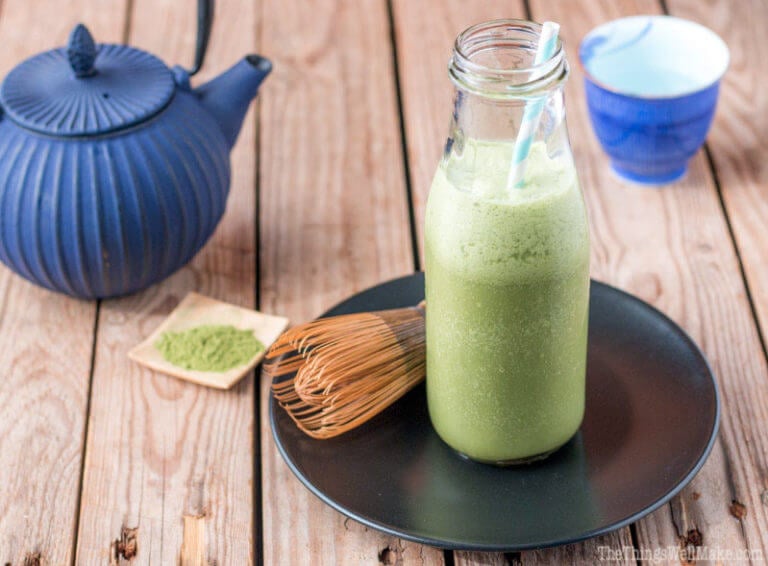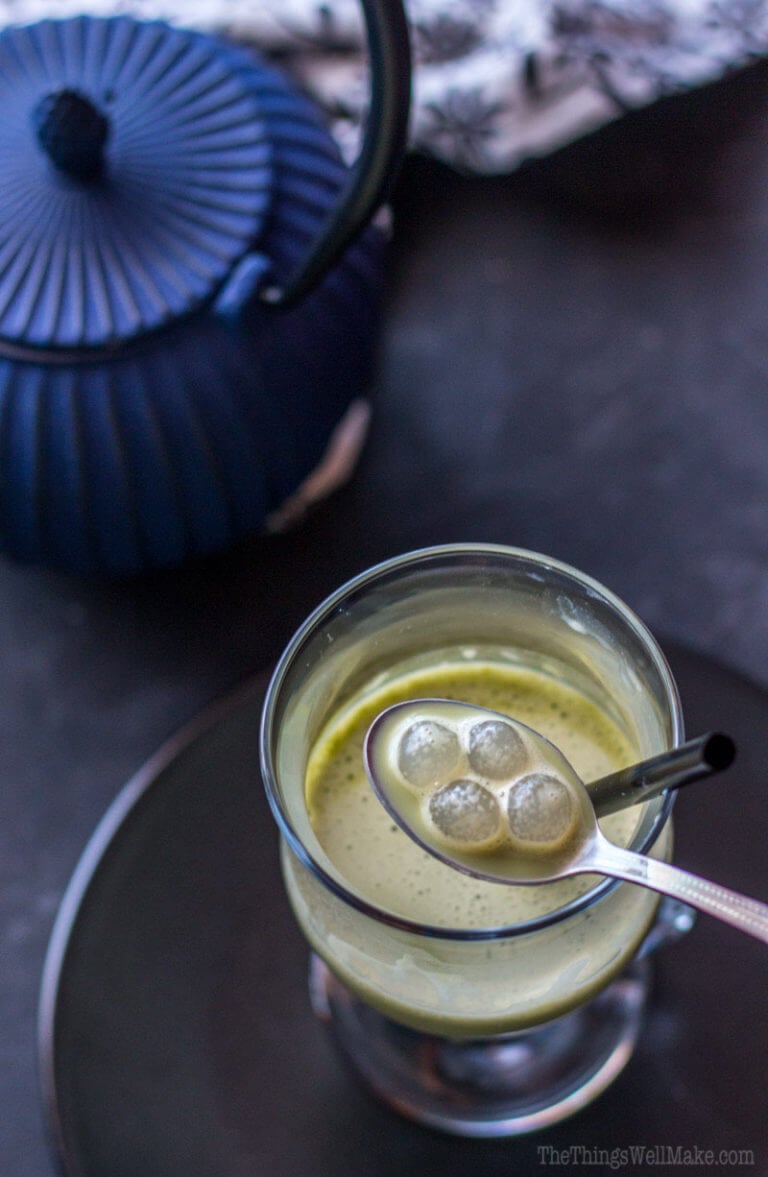As much as I appreciate a good cup of coffee, I’ve always preferred teas and herbal infusions. Especially in the summer, they just seem lighter and, when iced, more refreshing. Sometimes, though, I feel like having something a bit more substantial or more like a dessert.
Even if you avoid dairy, you can still enjoy the creamy satisfaction that comes from drinking a latte. Lattes are such versatile drinks because you can enjoy them, whether made with tea or coffee, in so many ways. In the winter, I enjoy frothing up the milk and heating it up as much as possible to slowly enjoy the latte as it cools off and warms me up. In the summer, though, I prefer loading it up with lots of ice and blending it into a frozen, slushy treat.
Lately, I’ve even chosen a new way to enjoy them: iced, and with homemade boba, or tapioca pearls, in a homemade matcha bubble tea!
What is bubble tea?
Bubble tea is a tea served with boba, also known as tapioca pearls. Boba are a chewy treat made with only tapioca flour and water, so they are gluten free, grain free, and even, dare I say it, paleo. Store bought tapioca pearls can be tricky to cook, though, so, as crazy as it sounds, I actually have found it easier to just make homemade boba tapioca pearls!
Paleo purists will probably turn up their noses to them, but when I’m craving something sweet and chewy, boba is definitely a better choice than a bag full of licorice. Just a few boba in the bottom of a glass and I feel like I’ve had my treat and can move on with my day.
Going back to the lattes, though.
I still choose a coffee latte every once in awhile, but lately I’ve been going to the classic tea favorites: the chai tea latte and the matcha latte.
Not only is matcha tasty and a beautiful shade of green that will brighten up your day, but it is also a superfood that is full of antioxidants known as catechins. Matcha is known to increase energy, but not in a way that will give you the jitters like coffee often can. Instead it helps you focus and be more productive. It is also thought to help stimulate your metabolism and to help you burn fat!
I often start off my day with a green turmeric lemonade, which is sort of like a superfood-enhanced lemon water with matcha and other ingredients. Sometimes, though, I head right for the matcha latte, so let’s see how to make one!
Paleo Matcha Latte
1 cup homemade coconut milk (Or other milk of choice–see notes below.)
1 tsp. matcha (find organic matcha powder here)
1 Tbsp. honey (optional, to taste) (find raw honey here)
1/2 cup hot water or ice (optional, depending upon method and milk used)
Hot Matcha Latte (Coffeemaker Method)
- Bring 1/2 cup of water to almost a boil, and remove from heat source.
- Whisk in matcha until fully incorporated and frothy, and add to your serving glass.
- In a separate glass, use the milk frother of the coffee maker to warm and froth your milk of choice. Pour it over the matcha in the serving glass.
- Add honey to taste.
Hot Matcha Latte (Blender Method)
- Add hot milk to your blender container.
- If you are using a thicker milk like store-bought coconut milk, I’d recommend also adding up to half a cup of warm water. If you are using a homemade coconut milk or a thin, light-flavored milk, you can add in up to another 1/2 cup warm milk.
- Add honey to taste and blend until fully mixed and frothy.
Cold Matcha Latte (Blender Method)
- Add 1 cup of cold, dairy-free milk into your blender container along with the matcha and honey, and blend.
- For an iced latte, serve with ice cubes.
- For a frozen, slushy type latte, add in ice cubes and blend again until smooth.
- Serve immediately.
Matcha Bubble Tea (with Homemade Boba)
- Boil 1/2 cup of tapioca pearls, storing them in honey once they are finished and removed from the water. (I find it easier and tastier to make my own tapioca pearls. You can find the recipe for how to make boba here.)
- Make your matcha latte, either cold or hot, using the recipes above. Make it slightly less sweet than you normally would because the boba are sitting in honey and will sweeten the latte somewhat when added.
- Add the boba to the bottom of the serving glass along with the honey they’ve been sitting in.
- Pour the prepared matcha latte over the warm boba and serve immediately.
Note: Boba are at their best texture when warm, so it’s a good idea to add them to the bottom of your serving glass first, while warm, and then pour your cold tea over them at the last minute when ready to serve.
[pin-embed url=https://www.pinterest.com/pin/188025353172285065/ size=large description=true]
Tips for using non-dairy milks
I like to make homemade coconut milk for lattes because I find the canned varieties too thick for a light drink. It may sound like something that is difficult to do, or something that would take a long time, but it really isn’t.
While I normally let the coconut sit for awhile in the water to fully extract the coconut milk goodness, for something like a latte, you can easily make the coconut milk quickly. For making lattes, I usually blend together some water with some shredded coconut and strain out the milk immediately. The milk may be on the lighter side, but I find it perfect for lattes that way.
To extract the remaining milk, I add more water to the pulp and blend it all again. I then let it sit for a couple of hours to help extract more of the coconut into the milk before straining out a second batch. I never throw the pulp away, and instead save it for homemade coconut flour.
For more details, you can read about the entire process of making coconut milk, coconut flour and coconut butter on my blog.
Other non-dairy milks
You can use any non-dairy milk in making lattes, but, of course, some will taste better and have better textures than others. When using heavier milks, like canned coconut milk, I mix them with some water to lighten them up.
Some of my favorites are almond milk, or mixed nut milks using cashews, sunflower seeds, and hemp seeds. While I love hemp milk in smoothies, I personally don’t love the flavor of it alone in lattes.
When using a new milk, it’s a good idea to taste it as you are making it. You may need more or less honey and/or water than what you are used to using with a different type. Have fun experimenting and finding your favorite combinations!




